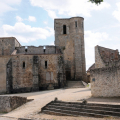THE MARTYRED VILLAGE OF ORADOUR-SUR-GLANE
A village rich in history, with a Remembrance Center offering an insight into the expansion of Nazism in Europe.
A visit to the village of Oradour-sur-Glane, walking between the ruins of the stone buildings that once made up this peaceful Haute-Vienne village, is not an experience that leaves one unscathed. It was here, some twenty kilometers north of Limoges, that the German army carried out the largest massacre of civilians in France. The ruins of the martyred village cover an area of 15 hectares. Classified as a historic monument on May 10, 1946, they have been maintained in the same condition as they were the day after the massacre. Signs invite those present to pay their respects on paths and roads where bullet holes can still be seen on the walls, as well as cars and rails left as they were. Oradour is a symbol of a France ravaged by German occupation. The preservation of this village after the massacre bears witness to this atrocious barbarity for future generations. Every year, 300,000 visitors stroll through the ruins of the martyred village, paying homage, remembering and bringing back to life those who were murdered. It's a difficult but important visit, which leaves a lasting impression and takes us back to the events of June 10, 1944.
Oradour-sur-Glane is a typical Limousin village, with its small shops, 15th-century church and tramway, used every Saturday by many Limoges residents who come to the village to stock up on provisions. The German presence in the area dates back to 1942, and did not change the daily life of the inhabitants to any great extent. However, the village's population almost doubled as a result of Spanish, Alsatian and Jewish refugees. Although Oradour-sur-Glane had no direct links with the Resistance, FTP companies (the Francs-tireurs et partisans resistance movement) were based in the woods of neighboring communes. In the spring of 1944, the German army noted an upsurge in resistance actions in the region, and clashes between maquisards and soldiers multiplied. The notoriously brutal2nd SS "Das Reich" Division, returning from the Eastern Front, advanced into New Aquitaine. Its soldiers terrorized the population, setting fire to entire villages and indiscriminately murdering resistance fighters and civilians alike.
On June 10, 1944, the tanks of the "Das Reich" division reached the gates of Oradour-sur-Glane. In the early afternoon, 200 German soldiers surrounded the village. They entered shops, houses and the three communal schools, where children had their medical check-ups, and ordered the population to assemble at the fairground. Commandant Diekmann, who led the battalion, asked to be told the location of a supposed clandestine arms depot hidden in Oradour-sur-Glane. No one in the village knew of the existence of such a cache. In a heart-rending farewell, the 180 men were separated from the women and children, and taken to six locations - barns and garages - requisitioned by the Germans. Soldiers opened fire, and the men fell to the hail of machine-gun fire. The corpses are then set alight, amid the cries of the survivors. Women and children were crammed into the village church, where the SS placed a crate of explosives whose charge did not prove powerful enough to cause the building to collapse. Some threw grenades, others fired machine-gun bursts, and then, to the agonized screams of the survivors, the German soldiers set fire to the church. Once the massacre is over, the soldiers seize livestock, motorcycles, cars and business crates. By the time the "Das Reich" division left Oradour-sur-Glane at dusk, the village had become one huge inferno. In the days that followed, groups of SS troops returned to bury the dead amid the still-smoldering rubble.
At the end of the war, after the devastation, it was time to rebuild. The new Oradour, rebuilt by the state, stands a stone's throw from the martyred village. It was President Vincent Auriol who, three years to the day after the appalling events in the village, laid the foundation stone for the new town. By 1953, almost 200 houses had been built, some of them occupied by residents who had escaped the massacre. The new Oradour is a typical example of post-war urban planning, with its right-angled streets. The church in the new village, inaugurated in 1953, features stained-glass windows designed by Pierre Parot and made by Francis and Pierre Chigot. Despite this desire to rebuild, the proximity of the ruins is a burden: Oradour-sur-Glane is a dead town, in a permanent state of mourning. The inhabitants are few and far between, and the streets, devoid of children, are extremely sad. There are no village festivities. The process of returning to normal life is a slow one: it will take several decades and will involve the creation of the Centre de la Mémoire. Five exhibition areas help visitors to understand why Oradour-sur-Glane, a peaceful village in the Haute-Vienne region, fell prey to Nazi barbarism.
Did you know? This review was written by our professional authors.
The strengths of this establishment:
Members' reviews on THE MARTYRED VILLAGE OF ORADOUR-SUR-GLANE
The ratings and reviews below reflect the subjective opinions of members and not the opinion of The Little Witty.






Un salto nel tempo in un luogo, rimasto " immobilizzato " dopo la strage di innocenti.
Da italiani conoscevamo le nostre stragi come Stazzema e Marzabotto oltre le Fosse Ardeatine.
Non sapevamo assolutamente di questa strage come interessante per noi, provare a capire le dinamiche e tensioni sociali oltre territoriali, con gli alsaziani.
Come vedere che anche in terra francese, come in Italia, non vi è stata vera giustizia ma un gran teatrino durato decenni, per vedere come i nazisti l' hanno fatta franca.
Il museo come tutto l' intero paese curato e valorizzato.